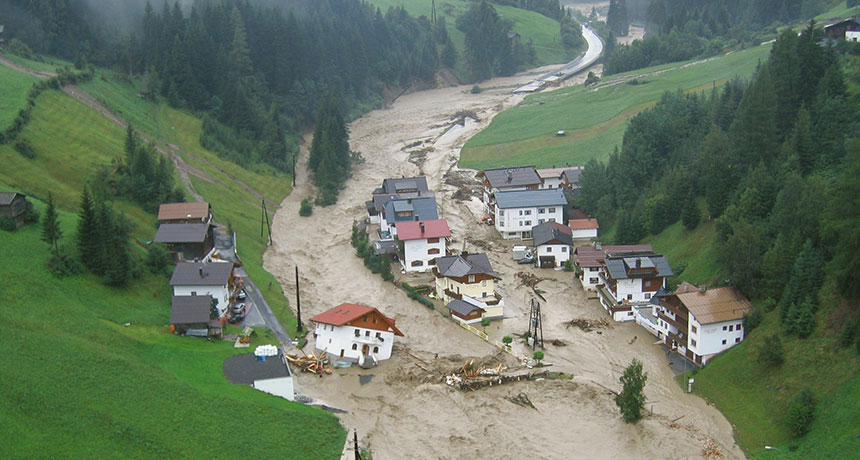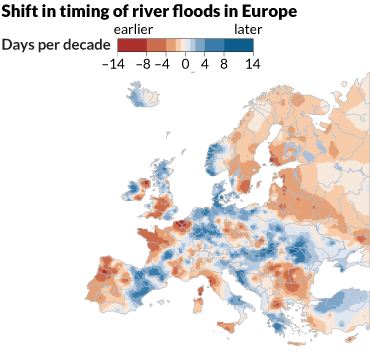Climate change is shifting when Europe’s rivers flood
Seasonal events such as snowmelt affect when, and if, waterways overflow their banks

In August 2005, severe floods hit alpine communities, such as this village in Tyrol, Austria. Over the past 50 years, the timing of when floods hit has shifted across Europe due to climate changes, a new study reports.
ASI/Land Tirol/BH Landeck
Across Europe, rivers aren’t flooding when they used to.
Some rivers now flood days, weeks or even months earlier than they did a half-century ago. Other areas now flood much later than before. Long-term changes in climate — in temperatures and precipitation — underlie these shifts. That’s the conclusion of a new study.
Floods are a part of life in many areas. But knowing when floods are most likely to hit allows people to plan and adapt. Farmers may consider floods when deciding when to plant or harvest crops. City planners may use flood predictions when designing storm sewers and other water systems. Shifts in the flood season also may have negative impacts on people, wildlife and farms near rivers.
Earlier studies had suggested climate change would likely increase the severity and frequency of coastal floods. But it can be tricky to link river flooding to climate change, notes Günter Blöschl. He is a hydrologist in Austria at the Vienna University of Technology. (Hydrologists study water systems in the environment.)
Sea level rise is the primary cause of worsening flooding along ocean coastlines. But along rivers, flooding is affected by a more complex set of factors, says Rob Moore. He is a policy analyst at the Natural Resources Defense Council in Chicago, Ill. Moore specializes in water issues, including flood risks. For rising rivers, he says, both the amount and timing of rains and snowmelt matter. So do the types of soil and whether the ground is dry or already waterlogged when rains hit. What’s more, how people have altered the land — such as damming rivers, building roads or removing forest cover — may also affect river flow. Those last changes aren’t climate-related but can alter flood risk.
Blöschl led a study to examine the seasonal timing of river floods. He worked with an international team of researchers from 38 countries. They analyzed hydrological data collected at 4,262 sites across Europe from 1960 to 2010. And factors unrelated to climate play a smaller role in flood timing than they do in the size or frequency of floods, this group found.
Flood season shifted per decade by as much as 13 days earlier or nine days later, they found. Over the full 50 years, that could amount to flood seasons showing as many as 65 days earlier or 45 days later than before!
The biggest changes were in Western Europe. There, flooding shifted by at least 36 days at one in every four monitoring sites. Elsewhere, effects were smaller. In northeastern Europe and the area around the North Sea, for instance, flood season had shifted by more than 8 days at more than half of the stations studied during the 50-year period. Blöschl’s team reported its findings August 11 in Science.
Flood effect

The effect varies by region because not all parts of Europe experience the same sorts of floods, Blöschl explains. Southern Sweden and areas around the Baltic Sea are in northeastern Europe. Here, snowmelt drives most flooding. When the local climate warms, snow will melt earlier in spring. This brings an earlier flood season. In contrast, southern England’s floods are due to rain falling on waterlogged ground. Heavy rains in autumn saturate the soil. Later deluges in winter cannot soak in. Flooding results. So here, winter tends to be the primary flood season.
The study did not address specific affects of shifts in when an area floods. It’s clear, though, that off-season flooding could have far-reaching impacts, especially if these trends continue. Surprise floods could impact animals that rely on certain river conditions to breed or to find food. Out-of-season floods or unexpected dry spells could also damage crops.
Finally, Moore points out, people are less prepared when big floods happen off-season. No one has yet done a study like this in the United States. But floods are occurring at unusual times there, too, he notes. Devastating floods swelled the upper Mississippi River to a record size in December 2015. The river would not ordinarily overflow its banks at that time of year. That 2015 flooding, combined with tornadoes spurred by the same storm system, killed more than 50 people. It also led to almost $2 billion in damage.







